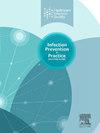Impact of the acute national blood culture bottle shortage on the two-set blood culture rate in a single center in Japan: Insights from an interrupted time-series analysis
IF 1.9
Q3 INFECTIOUS DISEASES
引用次数: 0
Abstract
Background
In 2024, a worldwide shortage of blood culture bottles prompted efforts to mitigate its impact, including strategies to reduce blood culture orders. This study aimed to evaluate the effect of the shortage on the two-set blood culture rate in a single center in Japan.
Methods
In this retrospective, single-center, observational study, blood culture data from April 2019 to January 2025 were analyzed. An interrupted time-series (ITS) analysis was performed to assess changes in the two-set blood culture rate, a key quality indicator. A Poisson segmented regression model was employed, with the shortage period as the breakpoint.
Results
The ITS analysis revealed a significant immediate reduction in the level of two-set blood cultures following the shortage (risk ratio [RR]: 0.22, P < 0.01), with a subsequent significant rise in the trend (RR: 1.25, P < 0.01). The two-set blood culture rate gradually improved after the supply restriction was lifted in October, returning to pre-shortage levels by December, following an intervention by the infection control team. The total blood culture test numbers remained stable during the study period (P = 0.64).
Conclusions
The blood culture bottle shortage led to a significant reduction in the two-set blood culture rate, demonstrating adaptation to shortage mitigation strategies. Monitoring the two-set blood culture rate served as an effective quality measure, enabling timely intervention by the infection control team and subsequent recovery of appropriate blood culture practices.The blood culture bottle shortage significantly reduced two-set blood culture rates. An interrupted time-series analysis showed an immediate drop, followed by recovery after an intervention. Monitoring enabled appropriate interventions to improve practices. Adapting strategies during shortages with continuous monitoring can optimize resources and patient care.
急性国家血培养瓶短缺对日本单一中心两套血培养率的影响:来自中断时间序列分析的见解
2024年,全球血液培养瓶短缺促使人们努力减轻其影响,包括采取减少血液培养订单的策略。本研究旨在评估短缺对日本单一中心两套血培养率的影响。方法对2019年4月至2025年1月的血培养数据进行回顾性、单中心、观察性研究。采用中断时间序列(ITS)分析来评估两组血培养率的变化,这是一个关键的质量指标。采用泊松分段回归模型,以短缺期为断点。结果ITS分析显示,短缺后两套血培养水平立即显著下降(风险比[RR]: 0.22, P <;0.01),随后趋势显著上升(RR: 1.25, P <;0.01)。在10月解除供应限制后,两套血培养率逐渐提高,在感染控制小组的干预下,到12月恢复到短缺前的水平。总血培养试验数在研究期间保持稳定(P = 0.64)。结论血培养瓶短缺导致两套血培养率显著降低,表明对短缺缓解策略的适应。监测两组血培养率是有效的质量措施,使感染控制小组能够及时干预,并随后恢复适当的血培养方法。血培养瓶短缺显著降低了两组血培养率。一项中断时间序列分析显示,该指标立即下降,随后在干预后恢复。监测有助于采取适当的干预措施来改进实践。在短缺期间通过持续监测调整策略可以优化资源和患者护理。
本文章由计算机程序翻译,如有差异,请以英文原文为准。
求助全文
约1分钟内获得全文
求助全文
来源期刊

Infection Prevention in Practice
Medicine-Public Health, Environmental and Occupational Health
CiteScore
4.80
自引率
0.00%
发文量
58
审稿时长
61 days
 求助内容:
求助内容: 应助结果提醒方式:
应助结果提醒方式:


